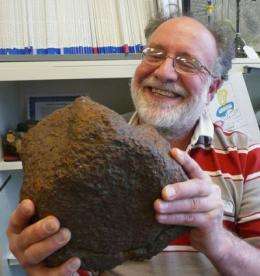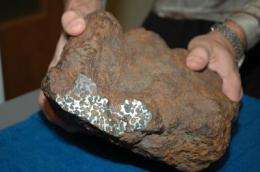Randy Korotev, PhD, research professor in Earth and Planetary Sciences at Washington University in St. Louis, with a new Missouri meteorite the owners allowed him “to fondle briefly,” on their way through town last January. Korotev’s lab analyzed the olivine crystals in the meteorite to help identify the meteorite's parent body and, together with analysis of the metal matrix done at UCLA, led to its validation as a unique stone by the Meteoritical Society. Credit: Dave Gheesling
Last January two amateur meteorite hunters dropped by Randy Korotev's office at Washington University in St. Louis to show him their latest purchase, a 17-kilogram pallasite meteorite found in 2006 near Conception Junction (population 202) in northwest Missouri.
Korotev, an expert in lunar meteorites, identified the stone as of a fragment of an asteroid. His lab also analyzed crystals within the rock to help identify its body of origin, eventually referring the meteorite hunters to UCLA for analysis of the metal in which the crystals are embedded.
The meteorite is a pallasite, a type of meteorite named for Peter Pallas, a German naturalist who first described one in 1749.
These meteorites consist of green olivine crystals embedded in an iron-nickel matrix like cherries in a pie, a rock type so odd that it was the first to be identified as extraterrestrial.
Not only are they beautiful, they are rare. The Conception Junction meteorite is only the 20th pallasite found in the United States so far.
Randy Korotev, PhD, research professor in Earth and Planetary Sciences at Washington University in St. Louis and an expert on lunar meteorites gets 700 queries a year from people who have found funny looking rocks. In this video, a variation on Kim's Game, also known as the Jewel Game (from Kim by Rudyard Kipling) he demonstrates ways to tell the difference between a meteorite and a terrestrial stone. For more information and to see a photo gallery of meteorwrongs, visit his web site at: http://meteorites.wustl.edu/what_to_do.htm Credit: Clark Bowen/WUSTL
And, like all meteorites, it carries within it a bit of the history of the early solar system. Pallasites are thought to be fragments of asteroids large enough to produce sufficient heat early in their history to partially melt and separate into a metal core and a rocky exterior.
Pallasites come from the lower mantle of these differentiated bodies and contain both metal from the core and olivine from the mantle. As such they are miniature models of planet formation that provide clues to what lies beneath our feet.
The meteorite's story
Karl Aston, a St. Louis chemist with an interest in meteorite collecting, spotted Korotev's extensive meteorite web site in 2007 and got in touch. Aston told Korotev he was trying to collect samples of all the twenty-some meteorites that have been found in Missouri.
"I'm working on the St. Louis meteorite," he said. "I've go some small samples; would you like them for your museum?'"
Of course, Korotev said "Yes, please."
The St. Louis meteorite, a stony meteorite, fell through the roof of a convertible driving down Florissant Avenue on Dec. 10. 1950. Contemporary accounts of the meteorite fall report a fireball some residents took to be an "A bomb explosion."
But Aston was also interested in new finds, and following in the footsteps of a legendary early-20th-century meteorite hunter named Harvey Harlow Nininger, he hunted for them by advertising in local newspapers for funny-looking stones.
He got lots of bum leads. "He'd call, I'd ask what was new," Korotev says, "and he'd say, 'Oh, you know how it is. I went out and I found another hematite concretion today." (Hematite concretions, which are sedimentary rocks, are one of the stones most commonly mistaken for meteorites.)
But in 2009 Aston heard from a farmer who had found an unusually heavy stone buried deep in a hillside near Conception Junction in 2006.
The farmer, who has asked to remain anonymous, had sawed off the end of the stone, revealing an interior impossible to mistake for that of a terrestrial rock.
The rusting fusion crust on the outside of the Conception Junction meteorite disguises it as just another rock, but one glimpse of the interior gives the game away. The olive-green crystals set in lustrous metal are unique to pallasites and so unlike anything on Earth that pallasites were the first rocks to be identified as of extraterrestrial origin. Pallasites are thought to come from the core/mantle boundary of differentiated asteroids, the olivine form the mantle and the metal from the core. Credit: Dave Gheesling
Aston didn't have the money to purchase the stone, so he brought in a partner, David B. Gheesling of Atlanta, Georgia. Gheesling's friend Robert Ward of Prescott, Arizona, also joined the endeavor, directing a systematic search of the area where the stone was found, on the chance that it had broken up on entry and there were more pieces.
On their way back from Conception Junction with the newly purchased stone, Gheesling and Aston stopped by Korotev's office so that he could examine it.
Naming the stone
The meteorite hunters were eager to learn whether they had a new stone or a fragment of a known stone.
If it was a unique stone, it could be submitted for naming to the Meteoritical Society, a nonprofit organization founded in 1933 for the study of extraterrestrial materials. Naming, which follows chemical characterization and comparison to other meteorites, amounts to acceptance by the meteoritical community of the stone's validity and uniqueness.
Korotev said, "Well, that's where we might be able to help you. The composition of the olivine might tell you.'"
Most of the 20 pallasites found in the United States belong to what is called the pallasite "main group" because the elemental composition of their olivine is similar.
But, as Korotev was aware, a pallasite found by a farmer near Milton, Missouri, in 2000 is "ungrouped," meaning it has a chemical composition unlike that of the main group pallasites.
"So they gave us a sample," Korotev, and Ryan Zeigler, PhD, then a research scientist in Earth and Planetary Science, prepared it and analyzed the olivine's elemental composition. We got the numbers and looked at them," Korotev says, and it was clear the stone was a main group pallasite. That meant it could be established as a unique stone only by studying the composition of the metal matrox.
Since WUSTL didn't have the tools or expertise to analyze the metal properly, Korotev referred the meteorite hunters to John Wasson of the University of California at Los Angeles for that work.
Wasson concluded that the new stone didn't match any of the other palllasites he's analyzed—"and he's analyzed practically all of them," says Korotev. So Conception Junction was unique.
UCLA became the repository for the type specimen of the new meteorite. Before the Meteoritical Society will recognize a meteorite, Korotev says, a representative specimen must be deposited in a museum or other institutional collection that routinely makes material available for scholarly research.
The Nomenclature Committee of the Meteoritical Society assigned the stone the name Conception Junction on Aug. 27, 2011.
In its sliced and polished state the meteorite is worth about $200 a gram. For comparison, the most common meteorites sometimes sell for as little as $2 or $3 a gram and pieces of the first lunar meteorite found by a private collector went for $40,000 a gram, say Korotev.
Meteorite prices depend on the type of the stone, its condition (some are unstable in Earth's atmosphere), the story that comes with it (one fetched by a dog commanded a higher price than usual) and many other factors. The meteorite market is not a good place to park your money.
"I don't know any rich meteorite collectors," Korotev says. "They do it mostly for the fun."
A wandering bit of the solar nebula
Of one thousand meteorites that strike the Earth, 998 are from asteroids, one is from the Moon and the other one is from Mars, Korotev says.
Conception Junction was once part of an asteroid that circulated in the asteroid belt between the planets Mars and Jupiter. The gas giant Jupiter played havoc in this zone, preventing material from the primordial solar nebula from coalescing into planets.
Much of the asteroid belt's original mass has been lost since the solar system formed, some fragments, like the Conception Junction meteorite, finding their way into Earth-crossing orbits.
Most meteorites from asteroids are from undifferentiated asteroids. But some, including Conception Junction, are from asteroids large enough that they produced sufficient internal heat to partially melt and separate into a metal core and a rocky exterior.
Meteorites blasted out of large asteroids can consist just of metal, just of stone, or—more rarely—mixtures of stone and metal, called stony irons.
The subgroup of stony irons called pallasites are thought to represent material from the boundary between the asteroid's metal core and the olivine of its lower mantle.
The boundary between Earth's mantle and core is probably similar.
"We can't break the Earth open," Korotev says, "we can't go down there and sample the rock, but we've got these pieces of broken asteroids that land on Earth, and they're made of the same stuff, they're just a lot smaller. "
SIDEBAR
What a Web site had to do with it "We wouldn't have been involved in the validation of the Conception Junction meteorite," Korotev says, "if Karl hadn't found my site."
Korotev still has heartburn over the Milton pallasite. Found before Korotev's Web site had much of a presence, this pallasite was shunted off to the University of New Mexico for analysis and verification.
"When I read the abstract a New Mexican colleague wrote about this unusual meteorite, I thought, 'How did that thing ever end up going to New Mexico?" Korotev says. As a point of pride, he didn't want that to happen again.
Korotev's site began as an online list of lunar meteorites first posted in 1994. Soon a Canadian pilot found the list and asked Korotev to identify a crater he had just flown over. Then queries started to come in about all sorts of funny-looking rocks that might be meteorites.
Before he knew it, Korotev was singlehandedly trying to stem a rising tide of industrial slag, sedimentary rock, volcanic rock, and just plain unidentifiable something or other. In self defense, he started to explain, and soon he was the webmaster of a large and highly entertaining educational site about meteorites. (http://meteorites.wustl.edu/what_to_do.htm) Almost all the meteorites people submit to him turn out to be what he calls meteorwrongs.
But roughly one in 300 candidates rocks submitted for his inspection is actually a meteorite.
The site also puts Korotev in touch with community of amateur meteorite hunters such as Karl Aston. As the roots of the word amateur suggest (it comes from amour, French for love), these are people who do science for the love of it. Not a bad crowd to know.
And some visitors do come away knowing more about meteorites. "You have the coolest website!," one of them wrote. "I am a little chapped, though. Before I found your website, I had six meteorite treasures that I had found. Now, thanks to your, 'It's probably not a meteorite,' I have NONE!"
Provided by Washington University in St. Louis




















